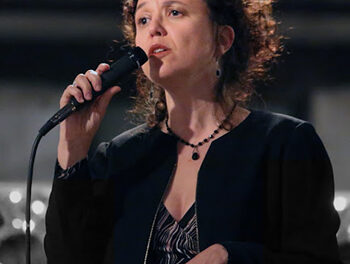Pulling into the North Carolina Museum of Art on Sunday afternoon, I noticed more cars and people than I’ve ever seen there. Parking was quite the challenge, as was navigating the lobbies en route to the concert hall, which was (once again) too small for the event. Many were there for the Frida Kahlo exhibit, but there was also a capacity crowd for this concert. Settling into my seat, I discovered the reason for the crush of humanity; this was a special performance, an addition to the regular season of Chamber Music Raleigh, to honor John and Nancy Lambert and Joseph and Elizabeth Kahn. Anyone enjoying chamber music in the Triangle, and especially anyone using CVNC, have these people to thank for many years of service. The concert was sponsored by Mary J. C. Cresimore.
Nancy Lambert was executive director of the Raleigh Chamber Music Guild, since renamed Chamber Music Raleigh, from 1995 to 2012. The organization grew greatly and prospered under her leadership. After 40 years of involvement in the arts community here, she received the Raleigh Medal of Arts in 2012.
John Lambert, with Joseph and Elizabeth Kahn, founded CVNC in 2001, with Elizabeth designing the first iteration of website you are using right now. The Kahns have a service writing program notes for classical music organizations, and it’s a good thing that they did the exhaustive notes for this concert. (This reviewer, like all too many Anglos, has little familiarity with Mexican chamber music, so the notes were extremely handy!) John continues service as editor in chief. It’s because he had a little faith in an oddball composer that I had the opportunity to sign on as a critic in 2016.
Although this was not a Sights and Sounds concert, it did follow the tradition of correlation with ongoing exhibits. The big show at NCMA until January 26 is “Frida Kahlo, Diego Rivera, and Mexican Modernism,” which I recommend. The Mallarmé Chamber Players chose works by four Mexican composers: Manuel Ponce, Silvestre Revueltas, Salvador Contreras, and Carlos Chávez.
The musicians formed a string quartet for two of the works and duets for the other two, spreading out the labor evenly. The violinists were NC Symphony members Robert Anemone and Jacqueline Wolborsky; Anemone is in the first violins, while Wolborsky is principal second violin. Violist Suzanne Rousso is artistic director of the Mallarmé Chamber Players (and a former education director of the NCS), and the cellist was Kirsten Jermé.
First up was Sonata a Duo by Ponce (1882-1948), the elder statesman of Mexican art music. This is a duet for violin and viola, performed by Wolborsky and Rousso, in three movements. It is in somewhat conventional form – conventional forms being what they are because they make sense and work well, don’t you know? The outer two movements are up-tempo, with the last being quite perky, and the middle is a lyrical Saraband. (Zarabanda? Sarabande? Sarabanda? Take your pick.) Ponce seemed content to have the viola play, well, second fiddle to the violin, but it worked. Wolborsky brought her usual flair and clarity of expression to the dominant upper part, and Rousso showed her many skills in expanding the work into true chamber music.
Next came String Quartet No. 2 (Magueyes) by Revueltas (1899-1940). All the musicians were on stage for this one, with Wolborsky taking on the first violin part. Revueltas had a rough life, heading off to do his part as a composer (!) in the Spanish Civil War in 1937. Nothing like a good march or fanfare to go along with Stalin vs. Hitler in the warm-up rounds! He returned to Mexico City and drank himself to death, for which you can hardly blame him. This three-movement work dates from 1931, mercifully before he descended into serialism and tone clusters. “Magueyes” means “agaves,” from which the alcoholic drink pulque is brewed; Revueltas said the name is just the expression of a mood. I’m not sure what the mood of an agave plant is, but I guess he had a clue. The quartet performed well as a unit.
Then we had the Sonata for Violin and Cello by Contreras (1910-82), in four movements, performed by Anemone and Jermé. Again, the form is conventional, with an allegro first movement, andante second movement, a scherzo, followed by a rondo. The idiom was somewhat more contemporary than in the first two works but still quite conservative by the norms of the time. This is not an easy work, and the two musicians handled the challenges in good form.
Finally, we had the String Quartet No. 3 by Chávez (1899-1978). The three movements were arranged from three of the nine parts of the ballet La jija de Cólquide. Chávez composed a good deal of music that is strongly influenced by Mexican indigenous material, and is the only one of the four composers heard here who worked personally with Frieda Kahlo and Diego Rivera. However, this piece, as with all of the afternoon’s music, was entirely assimilated into the general European style of composition. All the tempo markings and all the titles are straight from the continental tradition, and all four composers trained far from Iberian or Hispanic influences in their formative years. Anemone was first violinist this time, and again the collective effort was well put together and effective.
The audience was warmly appreciative of the four musicians and the honorees.











